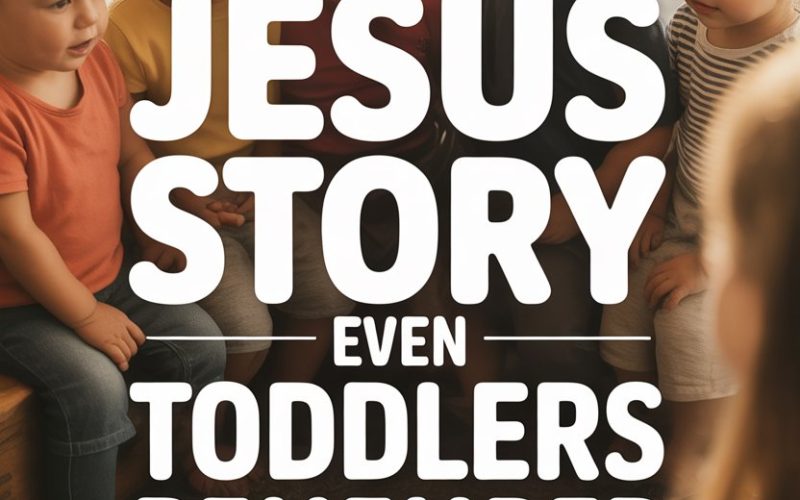When you’re chasing a toddler who thinks pants are optional and “quiet time” is a myth, you need stories that stick.
There’s one story that somehow seems to make it through the whirlwind of snack negotiations and bathtime theatrics—the story of Jesus and the children.
Now, don’t worry—this isn’t about theological dissertations or bedtime sermons so long that even the goldfish nods off.
This is about the bite-sized, heart-sized story that toddlers actually remember and why it matters for busy, tired, in-desperate-need-of-a-hot-tea parents like you.
Why This Tiny Story Endures
Long before little ones can recite all the verses of “Wheels on the Bus” (sorry for the earworm), many can tell you about Jesus welcoming children.
Not the resurrection, not the parables, not even the miracle of snack multiplication (although, honestly, if He could turn fish and loaves into enough to feed a crowd, He’d be a hit at every toddler birthday party).
It’s the moment when Jesus says, “Let the little children come to me.”
There’s a reason this snippet outlasts memory of what they did with your car keys. It’s short, it’s visual, and it’s one hundred percent aimed at their level.
In a world that often tells little ones to pipe down and wait their turn, here’s a grown-up—no, a really important grown-up—who says, “You matter.”
That’s powerful. For them, for you, for anyone who’s ever felt like the small person in a big room.
Small People, Big Message
Try telling your toddler “Mummy’s busy” and watch the Oscar-worthy meltdown unfold. Every day, little kids fight for attention in a universe that seems built for taller people.
Chairs are too high, rules are too long, and biscuits are always just out of reach.
Now, imagine a scene where a crowd is buzzing around a teacher everyone wants to meet. The grown-ups are shooing kids aside. But Jesus stops the show and says, “Let them come.”
He gives them hugs. He blesses them. He tells the adults, in no uncertain terms, that children aren’t a nuisance. They’re the VIPs.
Toddlers pick up on this. Quickly.
It’s a story where the smallest people are the main event. That’s rare.
And it’s a story kids remember—perhaps because every toddler, deep down, wants to be welcomed, wanted, and not just tolerated.
How to Tell This Story to Your Toddler
Short attention spans? No problem. This story fits right between “Peppa Pig” episodes and won’t spark a philosophical debate over milk choices.
Keep it simple. “Some people thought Jesus was too busy for kids. But Jesus said, ‘Let the children come to me,’ and He gave them hugs.”
Action: Act it out, using stuffed animals as the crowd, your child as the main character. Wrap them in a bear hug at the Jesus moment.
Suddenly, you’re not just telling a story. You’re living it.
Want to use a picture book? Fantastic. Look for one with bright, inviting drawings and real faces (nothing that looks like it escaped from a medieval tapestry—toddlers have standards).
Recommended by many parents, The Beginner’s Bible uses simple language and cheery art that’s toddler-tested.
The Science Behind a Story That Sticks
Why do little ones remember this story above all others? Turns out, there’s actual brain magic involved.
Early childhood experts explain that stories featuring emotional warmth and clear, relatable roles are more likely to be remembered by young brains.
That’s because these moments trigger the limbic system—the part of the brain that stores emotional memories.
And when a story makes your child feel “seen” or valued, their brain gives it a big, sticky note. According to one research study on children’s memory and attachment, positive emotional experiences increase memory retention.
Short version: stories where your child feels celebrated are stories they’ll keep.
The Power of Repetition (and How to Survive It)
If you’ve ever read the same picture book 46 times before breakfast, you know toddlers are repetition royalty. They don’t just like hearing the Jesus-welcomes-children story—they need it on repeat.
This isn’t just a quirky quirk; it’s how little brains wire up a sense of security.
Next time you find yourself thinking, “Didn’t we just do this?”—congratulate yourself. Repetition is building emotional muscle.
Tip: Change your voice for each character. (Bonus points for a grumpy “disciples” voice—think “no more biscuits” energy.) It keeps things fresh for you, and toddlers love the drama.
Making It Real in Everyday Life
Reading about Jesus welcoming children is lovely. Living it? That’s where the magic happens.
Look for those small moments to say “yes” to your child: crouching to their level when they want to show you a bug, pausing the to-do list for a cuddle, letting them “help” stir the cake batter (even if only two-thirds makes it into the bowl).
When you treat your child as important—especially when you’re busy—they’re living the story themselves. You become the person who says, “You matter.”
Research supports this, too. According to Harvard’s Center on the Developing Child, responsive interactions between adults and children are the foundation for healthy brain development, social skills, and lifelong confidence.
Answering Toddler Questions (Without Losing Your Mind)
After telling this story, you might get some real zingers:
- “Does Jesus wear socks?”
- “Can I be Jesus’ friend too?”
- “Why didn’t Jesus have a buggy?”
Simple answers work best. “Jesus loves you just like He loved the children in the story,” or, “Yes, you can talk to Jesus anytime.” And, “You can ask Him anything—even about socks.”
Don’t panic over getting it perfect. The goal is to make love, welcome, and kindness feel like home truths.
Snacks, Songs, and Sticky Fingers
Stories stick better when they’re multisensory. Toddlers don’t just want to hear about a welcome; they want to taste it, sing it, and smear it on their sleeves.
Why not celebrate the story with a mini “Jesus party”—juice, grapes, and a song about being loved? “Jesus Loves Me” with off-key warbling is practically a rite of passage.
If your child insists on a repeat performance, join in. You’re not auditioning for a talent show. You’re filling a little heart.
Pro tip: Don’t stress over crumbs. This is holy chaos, and that’s exactly what Jesus welcomed.
When You’re Too Tired for Stories
Some nights, “story time” is just code for “everyone’s still dressed and no one’s crying (much).” If you don’t have the energy to retell the story, a whispered, “Jesus loves you and wants you close,” works wonders.
Experts like Dr. Becky Kennedy, author of Good Inside, suggest that even the simplest bedtime rituals help children feel safe and secure.
A gentle touch, a loving word, and a familiar phrase can be enough.
You got the gold star just by showing up, even if you’re horizontal at the foot of the bed.
Growing Up with the Jesus Welcome
As your child gets older, the story of Jesus and the children doesn’t fade. It grows with them.
When they feel left out at nursery, when life feels unfair, when the world seems too big, the memory of being welcomed—just as they are—stays put.
Later, as they ask bigger questions, you can return to the story. Jesus didn’t just welcome children; He built a kingdom around people who felt small and unimportant.
That’s a lifelong lesson, tucked safely inside a toddler’s storybook.
The Story They’ll Tell Back
There’s a pretty good chance your child will grow up to retell this story to their own sticky-fingered little ones one day.
The magic isn’t in getting every word right. It’s in the way you scoop them close, grin at their questions, and make the welcome real—night after night, day after day.
You’re not just telling a story. You’re living it, one chubby-cheeked cuddle at a time.
And that’s a story worth remembering.





